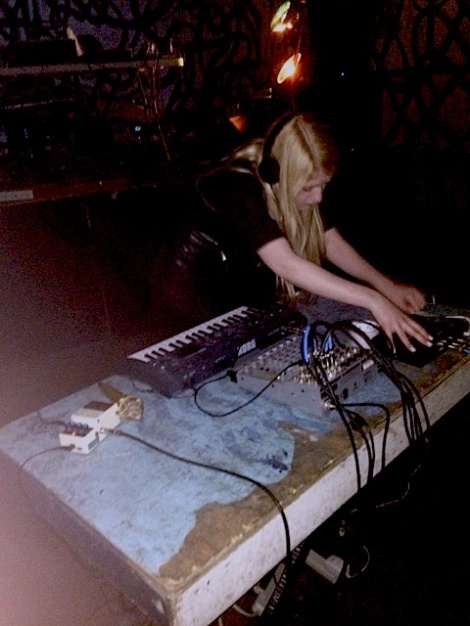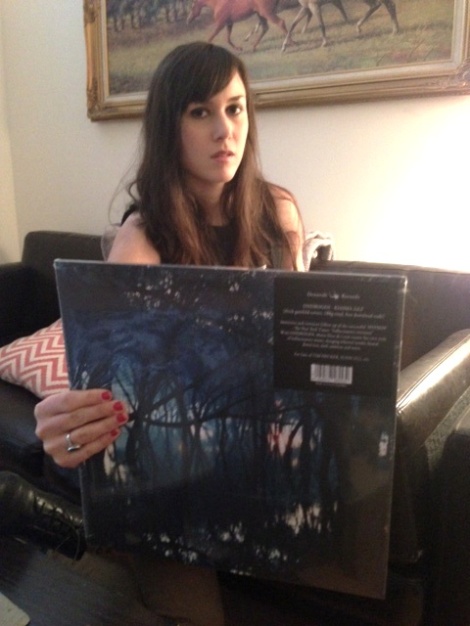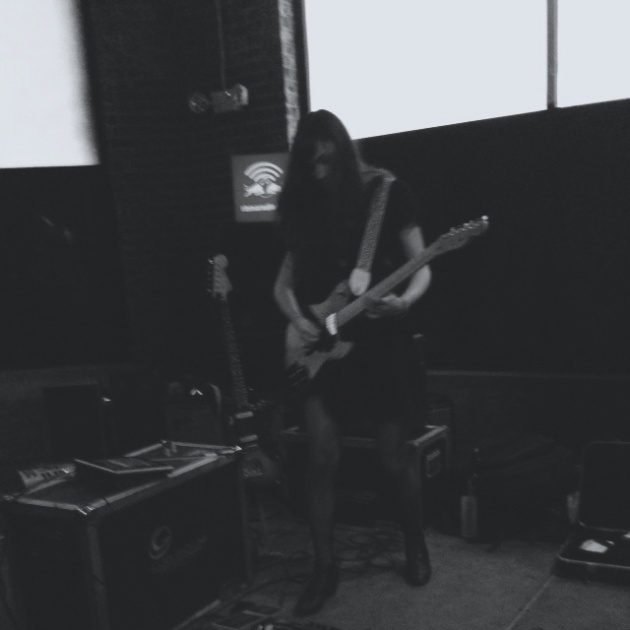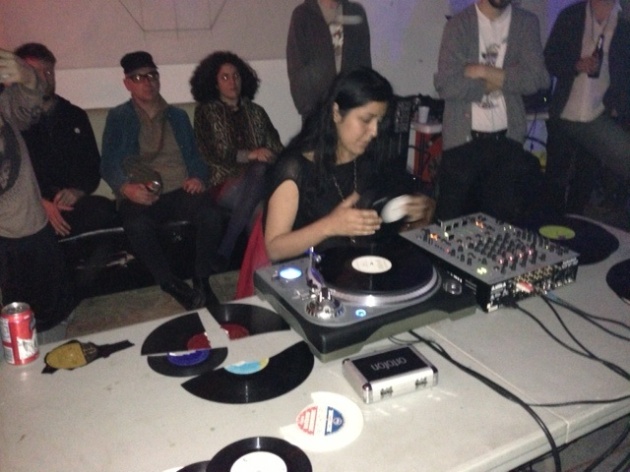PHARMAKON AT 285 KENT
It was April 7 when Margaret Chardiet, a 22-year-old noise artist who
performs under the professional name Pharmakon, seemed to be having a
bit of drouble dragging over her table of microphones, pedals, amps and a
multitude of sound-manipulating gadgets to the center of the room of
the dungeon of a venue that is 285 Kent in Williamsburg. A tall young
man with an accent, British or Australian it was hard to tell which,
walked up to her and offered to give her a hand.
Chardiet shook her head and said something along the lines of, “No, thanks, shouldn’t be playing the stuff if I can’t carry it.”
She continued on dragging, set up the equipment and the show went on.
She twiddled at her pedals and mountains of volume erupted from the
vintage-looking speakers. She shrieked, walked threateningly into the
crowd of 30 people and baited audience members by placing her hands on
their chests and shoulders in a manner that could be interpreted as
either threatening or playful. A crowd that counted noise “superstars”
like Nate Young, Spencer C. Yeh and Jason Lescalleet among its ranks
closed their eyes and nodded their heads in hypnotic solidarity.
Pharmakon is one of several female noise/experimental New York-based
acts getting attention in a traditionally male-centric scene and
re-igniting the genre all together. Noise music has much like other
aggressive forms of music including Hip-Hop and Heavy Metal been a bit
skewed towards dudes. But Pharmakon and other New York City-based acts
like 29-year-old sound manipulating guitarist Noveller, 33 year-old
sound artist Maria Chavez , 25-year old experimental musician C.
Lavender and others are some on the more buzz-worthy acts in the scene,
making a case that the female presence in noise and experimental music
is growing, and even that the notion of a boys club in noise is
obsolete, and all together stupid.
“It’s really hard to assess an exact figure for how many women are
making noise,” said the founder of extreme music blog Blastitude Larry
Dolman, “But I’d be willing to bet that if there was some math done
there’d be telling evidence that there are more women in this scene than
there were in the past. The noise scene is much different than it was
only five years ago.”
It should be mentioned that women making noise is no new phenomenon.
Composer Pauline Oliveros was making atonal sound art as early as the
1950s, and women like Lydia Lunch of Teenage Jesus and the Jerks and
Adris Hoyos of Harry Pussy have all left indelible marks on the scene as
it has progressed through the decades. And the women of this article
certainly have much love and admiration for all noise musicians, male or
female, “It’s up to you how you want to write this,” said Maria Chavez,
“But I really don’t think it’s beneficial to perpetuate a girls v. boys
theme.”
People don’t like discussing gender, and some might even find it
silly to think about in 2013, but it takes little observation to see
that there are more women in the underground noise scene. There is
definitely evidence pointing towards the ratio of men to women in the
scene equaling out.
Noise music’s increasing female presence is evident in the amount of
women playing noise festivals. The 2009 No Fun Festival (curated by
noise musician and owner of record label No Fun Carlos Giffoni that from
2004-2009 showcased the best in noise music at the Music Hall of
Williamsburg) had one female solo act out of 26 performers (Noveller)
(though women did play in some of the lineups of bands, ala Kim in Sonic
Youth as well as Cold Cave, Bardo Pond, Skullflower and Pedestrian
Deposit). The noise festival Ende Tymes that took place this past May 24
to 26 at the Silent Barn in Bushwick had seven female artists
performing out of its 44 (Maria Chavez, Zaimph, Rusalka, Pod Blotz,
Penny Royale, Tahnzz and Ghost Taco), a 14 percent increase in the
presence of female performers in four years time. While not an
overwhelming statistic, this signifies progress.
Though Bob Bellerue, who organizes Ende Tymes and performs noise as
Halfnormal, says he likes to keep the festival diverse, the influx of
female performers to the festival has been organic. This year has the
largest number of female performers in the festival’s history, but all
these women met Bellerue’s one requirement, “Everyone that plays Ende
Tymes has to be someone I really respect and want to see play,” he said
in an interview conducted by this author for Tiny Mixtapes.
Giffoni doesn’t believe there are more women in the scene now than
five years ago, “But perhaps there are more getting attention, maybe
that’s what’s happening,” he said in an Email.
In his profile of Michigan noise legends Wolf Eyes in “Wire” last
April, experimental music journalist Marc Masters made mention of noise
music losing appeal due to an overly-macho, testosterone-heavy and
drug-fueled sensibility. “Self-imposed rules crept in, threatening to
choke a scene that touted sonic freedom,” writes Masters. “[noise’]s
confrontational nature ultimately encouraged a macho, circus-like
atmosphere, with mostly white male audiences.”
All of the aforementioned female performers are gaining attention for their own unique take on the genre.
Pharmakon’s music is on the heaviest and harshest end of noise,
borrowing from other extreme genres like power electronics, industrial
and black metal, showcasing the music’s potential for violence and
ferocity. Her tendency toward the extreme might come from her
upbringing.
Chardiet grew up downtown with two punk rock parents that exposed her
to loud music. Her father took her to see anarchist punk band Nausea
when she was 14 years old. Noise proved to be the only music loud and
strange enough to shock her open-minded parents. “When I showed my
parents my music they said, “Great, you found the one thing more extreme
than what you were brought up with.”” said Chardiet in an interview with Pitchfork Media.
Pharmakon is choosy about the music she puts out, a rarity in a scene
whose performers often record and release every amplified metal scrape
to limited editions of 100 cassettes. Her new album “Abandon” on Sacred
Bones shows how her pickiness has benefited her, as it has been released
to high acclaim, getting four stars on Tiny Mixtapes.
Noveller, aka Sarah Lipstate, makes noise that is more delicate than
most in the genre. She started getting into noise as a teenager despite
her conservative John Denver-loving parents while working at her record
store in Lafayette, Louisiana, discovering downtown NYC-noise rock bands
like Sonic Youth and Teenage Jesus and the Jerks. But when moving to
New York in 2005, she found herself drawn to ambient music like Brian
Eno, and her music calmed down, with fuzzy guitar riffs interlaying
serene background sounds.
SARAH AKA NOVELLER SHOWS OFF A FAVE RECORD OF HERS
Playing music that uses heavy and quieter sounds is a powerful
experience for Lipstate, “It can be cathartic, even if it’s really
beautiful,” said Lipstate. “It’s not always the loudest and craziest
stuff that does this for me, sometimes it’s the more introspective
stuff.”
Her on stage persona is lighter than a lot of noise artists and she
just seems more approachable. She smiles in between songs and generally
just seems ecstatic to be doing what she’s doing, her recent performance
at the Red Bull Music Academy’s “Drone in Progress” in May demonstrated
her sincere love in her music. Her music has resulted in her being
featured in mainstream publications including Time Out New York, the
Wall Street Journal and the Village Voice, and she is now branching out
into film, working on upcoming films “Traitors”, “Grand Street” and a
few others.
NOVELLER AT RBMA’s “DRONE IN PROGRESS”
Maria Chavez came to experimental music through unlikely sonic means,
dance music. She started as a DJ in the early 00’s in her hometown of
Houston and while she maintained an interest in dance music she quickly
grew tired of the music’s treatment of women. “It seemed back then that
the only successful female house DJ was a topless D.J., ” she said
laughing.
MARIA AT ENDE TYMES
She stumbled upon the improvised music scene in her hometown, leading
her to sound art. She found herself under the tutelage of Pauline
Oliveros, an improvised music composer and one of the originators of
what would go on to become noise music. Oliveros was one of very few
females working in this style, and her success in a male-dominated world
made a strong impression on Chavez. “It was incredible to learn all
these practices that were started in the 50s by a woman,” said Chavez.
“I am really spoiled when it comes to strong female role models.”
Maria’s compositional training and experience as a DJ stuck with her.
Her music is more subdued and textured than harsh noise, consisting of
field recordings and test tone recordings.
“As an artist I’m just really interested in sound installation and
how sound is related to the perceptions of the listener,” said Chavez.
Hudson based-experimental musician C. Lavender (she prefers to be
referred to under this name) was a metal head in high school. She
studied guitar and wanted to play in a metal band. It didn’t pan out,
and she found herself in her room experimenting with sounds, not really
sure what her music would turn into “I didn’t really realize what I was
doing was noise,” she said, “I was sort of growing bored with music, and
this just seemed more fun.”
Her music is an interesting amalgam of highbrow and lowbrow. She
still loves metal and punk, citing British-anarcho Crass as an important
touchstone in her musical development. She has also played in absurdist
noise troupes like Cock ESP and the Laundry Room Squelchers, engaging
in the total musical violence that noise is sometimes capable of and
loved being a part of it, “Sometimes I liked playing with the Squelchers
more than I liked doing my own music.” But she is also a trained
musician. Like Chavez she has worked with Pauline Oliveros. She has also
studied dance extensively, and is applying this passion to her music,
incorporating experimental dance into her new project Tanz Praxis in
collaboration with LN Foster of Drums like Machine Guns. The meeting of
punk ethos and trained classicism forms a captivating juxtaposition.
The women involved with noise music for the most part do not seem to
like being categorized in terms of gender or otherwise. Chardiet
declined an interview request upon learning what this article deals
with. “Margaret tends to shy away from any piece or show that focuses on
her gender,” said Chardiet’s younger sister Jane who runs an extreme music blog under the moniker Jane Pain in an Email..
C. Lavender hopes her music speaks for itself itself, “I think the
gender thing is just a silly question these days,” she said, “I just
have more fun making these sounds.”
Chavez doesn’t like the idea of a “girls vs. boys” scene, but she
does have her own ideas about what women might do differently than men.
“I feel women have a closer relationship with the instinct of the
moment,” she said, “I feel like what’s happening right now is the women
that are getting recognition are the ones who perform in tune with their
instincts.”
She related a story about performing in Krakow, “I played a set, and I
thought it was just really nice, and really smart,” she said. “After I
played all the guys there told me it was good but they wanted to hear me
go nuts and play a really loud one. I said, “So you guys just want me
to make a ton of noise, right?” Of course they did.”
So why is it that these women and others are now playing such a
prevalent role in noise now, especially when there have always been a
few women scattered about the scene throughout history?
The Internet has exposed people to noise music at a rate that was
previously impossible. In the 90s, the only places to read about this
music were small zines like Bannanafish. Now, Pitchfork has an
experimental and noise music column “The Out Door”
by Marc Masters and Grayson Currin that every month enlightens the
indie brethren what is going on in noise, sound art and experimental
music. Spin Magazine covers noise regularly, having run a feature on
Pharmakon earlier this year. Even mainstream publications are taking
notice, with Noveller being written up in Time Out New York and the New
Times, and Chavez getting featured in Interview Magazine and the Village
Voice. And with all this information filtering through a 24-hour
endless web stream, noise is just easier to hear about for kids these
days. Chavez feels that the noise scene is expanding overall and the
influx of women is a by-product of the noise scene’s growth. “I think we
are just starting to see what the Internet is capable of in terms of
what it can do for this scene,” she said.
Noise is also economical. You need no musical training to start a
noise band, and you don’t need any flashy instruments, in a generation
of post-collegiate habitually unemployed kids in their early 20s, this
is appealing “You know how people say that what was great about punk was
that anyone that learned three chords could play it?” said Bellerue,
“With noise you don’t even need the chords.
Some of noise’s vets, like Giffoni, feel that noise is and always
will be the true underground music, incapable of reaching a mainstream
audience, and he is perfectly fine with that, “Wolf eyes played
Coachella six years ago,” he said, “We had our chance, and we blew it.”
But noise music continues to grow, and as such the younger generation
of talent in the scene has a more hopeful outlook, believing that more
women will become interested in it. Chavez has a particularly optimistic
outlook concerning the future of noise, “I feel that at the rate the
scene if progressing, than that 10 or 20 years down the road noise could
be in the mainstream,” she said.
This may not be that extreme of a belief. Bands like Animal
Collective and Deerhunter have roots in abstract and atonal noise, and
it’s hard to imagine electronic acts like Zomby or Laurel Halo or even
Grimes amassing the audience they have 15 years ago.
There are still more men making noise music than women. Despite seven
performers being female at Ende Tymes, the other 37 were male. This of
course isn’t unique to noise music in any way, as other aggressive forms
of music seem to have a bigger pool of men than women, whether it
Hip-Hop or Heavy Metal.
But if Chavez’s assertion is in anyway correct, and that if noise
continues to reach larger audiences, than in theory there will be no
more articles such as this, and the examining of a “growing presence of
women in noise” will prove obsolete.
“If more girls are playing than more girls are going to be comfortable and going to the shows,” she said.



